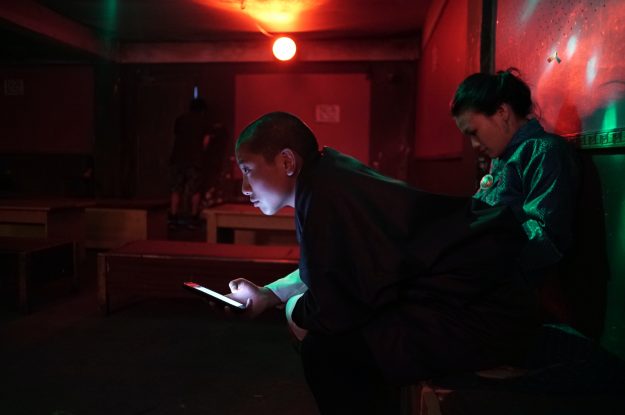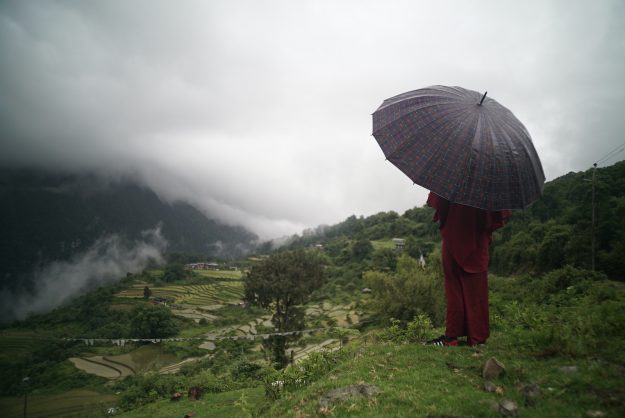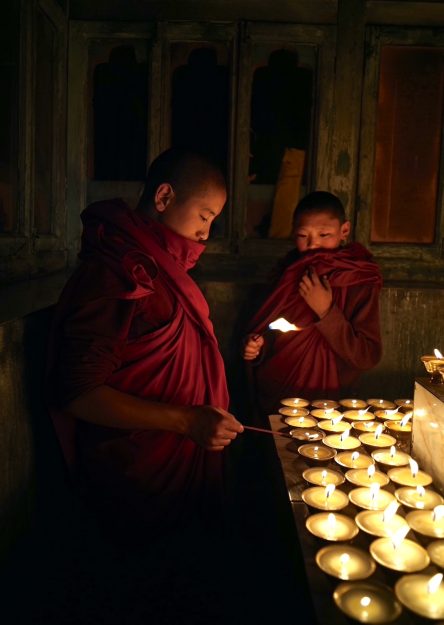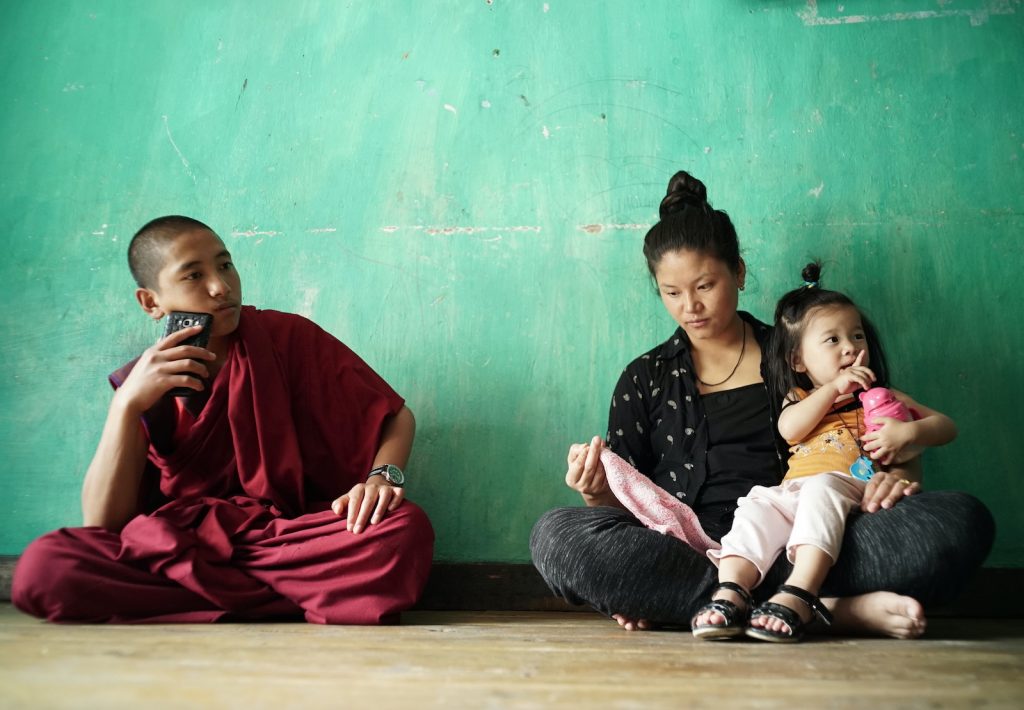In the award-winning documentary Happiness (2014), acclaimed French filmmaker Thomas Balmès captures the life of an 8-year-old monk in Bhutan named Peyangki. With his new documentary Sing Me a Song, released on January 1, 2020, Balmès returns to Bhutan to follow the now-teenaged Peyangki and creates a nuanced portrait of a young man learning about the world beyond his monastery.
Several years have passed since the Bhutanese government began lifting bans on TV and internet use in the country, and now the daily rituals of monastic life compete with the powerful lure of smartphones. Disinterested in study, Peyangki privately forms a relationship on social media with a singer from the capital city of Thimpu and aims to leave the monastery in search of “the one he dreams of night and day.”
While other documentaries like The Social Dilemma (2020) sound the alarm on social media manipulations and their real-world consequences, Sing Me a Song offers a unique perspective: that of a young monk’s coming of age in a new era of connectivity. Caught between tradition and modernity, Peyangki’s journey, occasionally crushing and painful, has universal resonance.
Tricycle caught up (virtually) with Balmès at his home in Normandy, to talk about the tension between technology and tradition, the impacts of connectivity on society, and the power of film to hold up a mirror to our addictions.

In your documentary Happiness, Peyangki seemed to embody the Buddhist teaching about “child-mind”—approaching experience with a sense of wonder, without expectation. When you returned for the new film, what differences did you observe? I have to say that when I came back to shoot Sing Me a Song, the first thing I observed was this scene of the young monks in the monastery, praying and playing [on their phones] at the same time. And I felt most of them had their brains turned off. The innocence that was there earlier, when shooting Happiness, that was lost.
On one hand, this is meaningful, and connects with what the film is about. But on the other hand, I was afraid that we would miss seeing that, how Peyangki was filling up the screen with so much joy and innocence in the first film. But the reality of becoming a teenager in combination with the use of screens [changed him].
[In Bhutan,] they went from nothing, no screens, to, in a few months, watching 15 hours of American wrestling and porn a day. They don’t have the slightest notion of the potential negative effects of going from nothing to becoming the biggest users of screens in all of Asia. In Europe, we had TV first, and then the internet, and then mobile phones. Bhutan, they got everything all at the same time.
Did you notice technology being used in interesting ways? Or did it feel like an erosion of culture via tech addiction was taking place? From what I saw, all the teachers in the monasteries were as addicted to screens as the younger generations. In the evenings, sometimes I met with the head of the monastery, and I would see him with two iPhones, one iPad, and a computer, using all four screens at the same time. From what I observed, everybody has some kind of addiction.
Also, I think I’m the worst person when speaking about being addicted to these kinds of tools. I’ve ended up in my career with two or three mobile phones in my pocket, one for private, one for work, one for when I am abroad. So, this isn’t something I look at from a distance. Even with my family, not a day goes by where I’m not experiencing some conflict with one of my kids on this issue. It’s a daily endless battle. And how do you deal with it when homework is being done on the internet? Like my kids, everyone on Earth is spending 13 hours a day on screens. And I don’t have the slightest clue on how to solve it. There is not a single country that has the right solution.
You hear about the people who are creating this technology, the founders of the tech companies, how they behave—they send their kids to Montessori schools where there are no screens. They know the potential threat if there is not some sort of control. I think we need to be more educated about these tools, how these applications manage to implement an addiction to the users, which are as addictive as any kind of drug.

From your observation, did Peyangki’s spiritual grounding provide a buffer against the pervasive influences of the social media apps he was so immersed in? To me, technology and the development of all these apps is connected to capitalism and consumerism. I think that [consumerism] doesn’t work on Peyangki. One of my favorite sentences in the film is when he says, “I don’t like money—when you don’t have any you need to earn it. And when you have it you need to spend it.” And he is genuinely like that, he is one of the least materialistic persons I’ve ever met. And I think that’s something he shares with many monks and people in Bhutan. I would say this attitude is less and less and is going to change. And yet, I don’t think you would hear any teenager in France who would tell you such a sentence.
Many movies today are filled with rapid-fire montages and wall-to-wall music. I appreciated how your film didn’t tell me what to think but allowed me to engage with it, to slow down and linger in the moments and silences. It allowed me to form my own relationship with what I was watching. This relationship with rhythm and pace is cultural. It’s interesting because I cut my previous films with an older editor, and she allowed a very slow pace. With Happiness and Sing Me a Song, I’ve been working with much younger editors, born 30 years after me, and so every shot is discussed between their culture and my culture.
To me, Sing Me a Song is super efficient, and I’m always very concerned about not being too efficient. To me, efficiency is manipulation, and I don’t want to be manipulative. I’m keen to leave a lot of time to the viewer to make up their own mind about the meaning of what is being said.
On the other hand, I was in Sundance, showing Happiness, and two American women came out of the theater and said, “Oh my God, this is so slow, so boring!” I always take that to the editors and remind them of these two women from Sundance and say, “We must be a bit faster!”

This film comes at a time when many Bhutanese think consumer culture is eroding the country’s traditions. What do you hope Bhutanese and other viewers will take away from this film? Something I want to point out is I don’t think the film is about Bhutan. The film is about us, and people see what they want to see in it. [In Happiness] Peyangki was spending days and days with no one around, with nothing to do in the monastery, and never getting bored. Now, there is not the slightest moment of his life today where there is this emptiness. It’s done. Just like everybody. There is not the slightest moment where we can be by ourselves. Nowadays, you go to the toilet, you take your phone. I’m not sure this is the best thing we have brought to our lives.
It’s funny because I started this film 10 years ago and it could not be more apt today. Since I started the project, we have arrived at a really critical situation: [this technology] is impacting our social life, including democracy and politics. I really hope that the film will create some kind of dialogue. In France we have shown the films in schools and universities, and it has resulted in a lot of discussions. When COVID is over, we will definitely try to do the same in Bhutan as well.
Thank you for subscribing to Tricycle! As a nonprofit, we depend on readers like you to keep Buddhist teachings and practices widely available.
